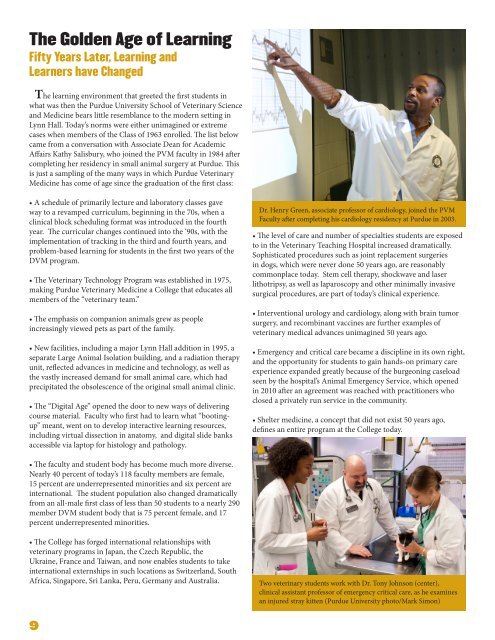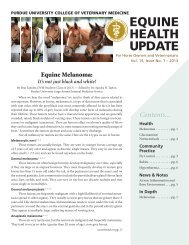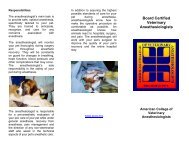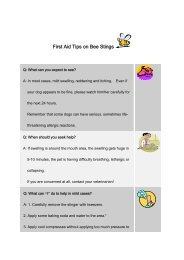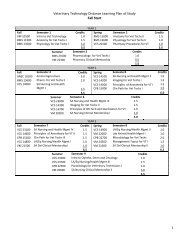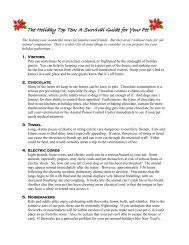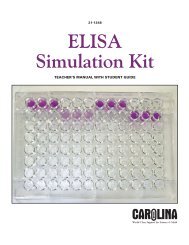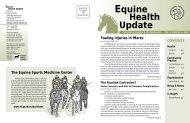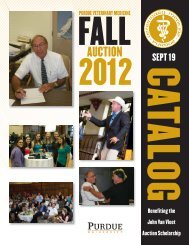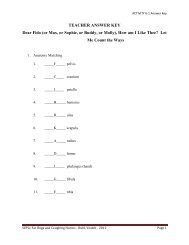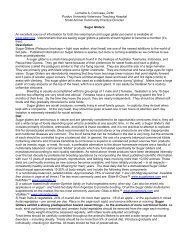2013 PVM Report - Purdue University School of Veterinary Medicine
2013 PVM Report - Purdue University School of Veterinary Medicine
2013 PVM Report - Purdue University School of Veterinary Medicine
Create successful ePaper yourself
Turn your PDF publications into a flip-book with our unique Google optimized e-Paper software.
The Golden Age <strong>of</strong> Learning<br />
Fifty Years Later, Learning and<br />
Learners have Changed<br />
The learning environment that greeted the first students in<br />
what was then the <strong>Purdue</strong> <strong>University</strong> <strong>School</strong> <strong>of</strong> <strong>Veterinary</strong> Science<br />
and <strong>Medicine</strong> bears little resemblance to the modern setting in<br />
Lynn Hall. Today’s norms were either unimagined or extreme<br />
cases when members <strong>of</strong> the Class <strong>of</strong> 1963 enrolled. The list below<br />
came from a conversation with Associate Dean for Academic<br />
Affairs Kathy Salisbury, who joined the <strong>PVM</strong> faculty in 1984 after<br />
completing her residency in small animal surgery at <strong>Purdue</strong>. This<br />
is just a sampling <strong>of</strong> the many ways in which <strong>Purdue</strong> <strong>Veterinary</strong><br />
<strong>Medicine</strong> has come <strong>of</strong> age since the graduation <strong>of</strong> the first class:<br />
• A schedule <strong>of</strong> primarily lecture and laboratory classes gave<br />
way to a revamped curriculum, beginning in the 70s, when a<br />
clinical block scheduling format was introduced in the fourth<br />
year. The curricular changes continued into the ‘90s, with the<br />
implementation <strong>of</strong> tracking in the third and fourth years, and<br />
problem-based learning for students in the first two years <strong>of</strong> the<br />
DVM program.<br />
• The <strong>Veterinary</strong> Technology Program was established in 1975,<br />
making <strong>Purdue</strong> <strong>Veterinary</strong> <strong>Medicine</strong> a College that educates all<br />
members <strong>of</strong> the “veterinary team.”<br />
• The emphasis on companion animals grew as people<br />
increasingly viewed pets as part <strong>of</strong> the family.<br />
• New facilities, including a major Lynn Hall addition in 1995, a<br />
separate Large Animal Isolation building, and a radiation therapy<br />
unit, reflected advances in medicine and technology, as well as<br />
the vastly increased demand for small animal care, which had<br />
precipitated the obsolescence <strong>of</strong> the original small animal clinic.<br />
• The “Digital Age” opened the door to new ways <strong>of</strong> delivering<br />
course material. Faculty who first had to learn what “bootingup”<br />
meant, went on to develop interactive learning resources,<br />
including virtual dissection in anatomy, and digital slide banks<br />
accessible via laptop for histology and pathology.<br />
Dr. Henry Green, associate pr<strong>of</strong>essor <strong>of</strong> cardiology, joined the <strong>PVM</strong><br />
Faculty after completing his cardiology residency at <strong>Purdue</strong> in 2003.<br />
• The level <strong>of</strong> care and number <strong>of</strong> specialties students are exposed<br />
to in the <strong>Veterinary</strong> Teaching Hospital increased dramatically.<br />
Sophisticated procedures such as joint replacement surgeries<br />
in dogs, which were never done 50 years ago, are reasonably<br />
commonplace today. Stem cell therapy, shockwave and laser<br />
lithotripsy, as well as laparoscopy and other minimally invasive<br />
surgical procedures, are part <strong>of</strong> today’s clinical experience.<br />
• Interventional urology and cardiology, along with brain tumor<br />
surgery, and recombinant vaccines are further examples <strong>of</strong><br />
veterinary medical advances unimagined 50 years ago.<br />
• Emergency and critical care became a discipline in its own right,<br />
and the opportunity for students to gain hands-on primary care<br />
experience expanded greatly because <strong>of</strong> the burgeoning caseload<br />
seen by the hospital’s Animal Emergency Service, which opened<br />
in 2010 after an agreement was reached with practitioners who<br />
closed a privately run service in the community.<br />
• Shelter medicine, a concept that did not exist 50 years ago,<br />
defines an entire program at the College today.<br />
• The faculty and student body has become much more diverse.<br />
Nearly 40 percent <strong>of</strong> today’s 118 faculty members are female,<br />
15 percent are underrepresented minorities and six percent are<br />
international. The student population also changed dramatically<br />
from an all-male first class <strong>of</strong> less than 50 students to a nearly 290<br />
member DVM student body that is 75 percent female, and 17<br />
percent underrepresented minorities.<br />
• The College has forged international relationships with<br />
veterinary programs in Japan, the Czech Republic, the<br />
Ukraine, France and Taiwan, and now enables students to take<br />
international externships in such locations as Switzerland, South<br />
Africa, Singapore, Sri Lanka, Peru, Germany and Australia.<br />
Two veterinary students work with Dr. Tony Johnson (center),<br />
clinical assistant pr<strong>of</strong>essor <strong>of</strong> emergency critical care, as he examines<br />
an injured stray kitten (<strong>Purdue</strong> <strong>University</strong> photo/Mark Simon)<br />
9


